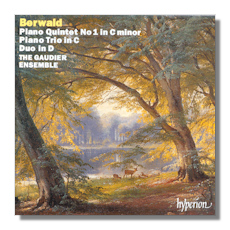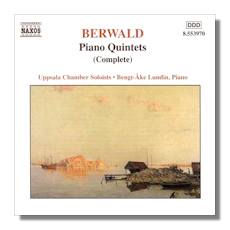
The Internet's Premier Classical Music Source
Related Links
- Berwald Reviews
- Latest Reviews
- More Reviews
-
By Composer
-
Collections
DVD & Blu-ray
Books
Concert Reviews
Articles/Interviews
Software
Audio
Search Amazon
Recommended Links
Site News
 CD Review
CD Review
Franz Berwald

Chamber Music, Volume 2
- Quintet for Piano and Strings #1 in C minor
- Duo for Violin & Piano in D Major
- Piano Trio #4 in C Major
Susan Tomes, piano
Gaudier Ensemble
Hyperion CDA66835 (1996)
Also available on budget re-release Hyperion Dyad CDD22053 with complete chamber music:
Amazon
- UK
- Germany
- Canada
- France
- Japan
- ArkivMusic
- CD Universe
- JPC


Complete Works for Piano Quintet
- Quintet for Piano and Strings #1 in C minor
- Quintet for Piano and Strings #2 in A Major
- Larghetto & Scherzo in A Major
Bengt-Åke Lundin, piano
Uppsala Chamber Soloists
Naxos 8.553970 (1996)
Recently I came across at a store the new Naxos CD of Berwald's Piano Quintets. Remembering that I had an Hyperion CD of Berwald chamber works containing the Piano Quintet in C minor, I decided to buy the Naxos and compare the two.
For those not familiar with Berwald, he was a Swedish composer who lived from 1796 to 1868. Swedish audiences were not hospitable to orchestral works, and Berwald found the environment quite restrictive and not favorable for his musical pursuits. He twice left Sweden and found much musical favor in Vienna. However, for much of his adult life, Berwald was a professional man with occupations as wide ranging as factory owner and surgeon. It wasn't until his final return to Sweden that Berwald composed his piano quintets, so they are works of his maturity which fully display his craft, inventiveness, and artistry.
Berwald was an early romantic composer moving toward the full bloom of romanticism. He was somewhat eccentric in his compositions; he often is flowing along with a particular theme and then, shazam, he's off on what seems like a totally different planet. I consider this feature one of the core ingredients of Berwald's music, and further listening does help to "connect the dots". Berwald was not a great innovator, but he was highly inventive as the Piano Quintet in C minor clearly reveals.
An important consideration to keep in mind is that Berwald was not much of a "piano man". Consequently, the piano parts in the Quintet in C minor are more supportive than central to the composition, although the significance of the piano does grow in the third movement. So, the performances of Tomes and Lundin take on a reduced importance.
The Quintet's first movement is Allegro molto with a charming and mostly slow Scherzo in the middle which does return at the end of the movement. The first theme is fast, powerful, and urgent; the Scherzo is very tender and lovely with strong longing. The immediate difference one notices from the two versions is that the Hyperion sound acoustic is quite rich, and the Gaudier Ensemble play the movement in a similar fashion with rounded contours. The Naxos acoustic is relatively stark, and the Uppsala Chamber Soloists provide much more of an edge to the Allegro molto and a delicious "Viennese" atmosphere to the Scherzo. It's no contest - Naxos by a wide margin. Why? First, the music is rich enough without adding more of it to the soundstage and/or performance. Second, the Naxos Allegro molto is bracing in its impact and very sharp with great urgency; the Hyperion Allegro molto sounds superficial, undernourished, far too smooth, and of low urgency. I had to crank up the volume controls to get any internal charge out of the music. Third, the Scherzo from the Gaudier Ensemble, while lovely, has little depth; in the hands of the Uppsala Chamber Soloists, I easily imagined I was comfortably reflecting at an outdoor cafe in Vienna. This first movement is Berwald at his best, and it's masterful music. In my humble opinion, the Gaudier Ensemble does not hit the mark and plays the movement as if it was written by Dvořák. Many ensembles make this mistake; they must think that Romantic-era music is home plate.
The second movement, Adagio quasi andante, has some beautiful melodies but not the variety nor inventiveness of the first movement. It's primarily tender and soft-spoken with some climaxes toward the middle. This movement does not have the characteristic Berwald trait of venturing without a moment's notice into another world.
If you listen to the second movement climaxes from the Gaudier Ensemble, you will hear such romanticized and overbearing performances which strike at the heart of this ensemble's problems with Berwald. Turn to the Uppsala Chamber Soloists, and the climaxes are powerful with plently of depth without going the romantic route. Again, no contest - the Naxos is idiomatic, the Hyperion wrong-headed.
The third movement, Allegro assai e con spirito, brings us back to Berwald's usual high level of invention. It has power, momentum, drama, playfulness, tenderness, and a frisky quality; they all add up to a dynamic musical experience with new themes consistently entering the mix. Although I was expecting to find the same results as in the first two movements, that didn't happen at all. The Gaudier Ensemble are now the group which is urgent and strong with a deliciously frisky and playful element. Tomes is superb with the playfulness of the music. The group is decidedly less romantic in this movement than the first two. By contrast, the Uppsala Chamber Soloists are somewhat spongy and weak in their attacks. Lundin is playful but only in a distant sense.
Every review I have read of the Gaudier Ensemble's recording has been highly complimentary. I have enjoyed it also over the past 2 years, but comparing it with the Naxos version illuminates the issue of "how romantic" do you want a work of an early-romantic composer to be played. I feel that in the first two movements, the Gaudier Ensemble play in too romantic a fashion; now and then, I heard an affinity with Faure. It makes recommendations difficult after the excellence of the Gaudier's third movement. Ultimately, I have to go with the Naxos version: the allegro movements even out, leaving the superiority of the Naxos in the second movement. That doesn't really please me since the deciding factor, the second movement, is the least enjoyable of the three. Oh well, I have both and I'll keep them.
Don's Conclusion: Assuming Berwald is up your alley, get both versions. If you like Berwald played as a "full romantic", it's best to just buy the Hyperion; I doubt the Naxos would be to your liking. My conclusion on the cover art: neither one appeals to me. My conclusion on Hyperion vs. Naxos: I'm going back to the Bach Partitas where it's warm, secure, and there are no trick questions to answer.
Copyright © 2000, 2011, Don Satz





















